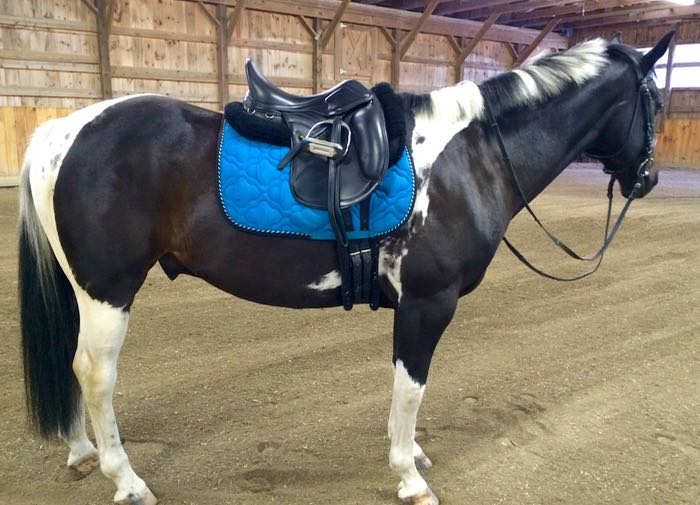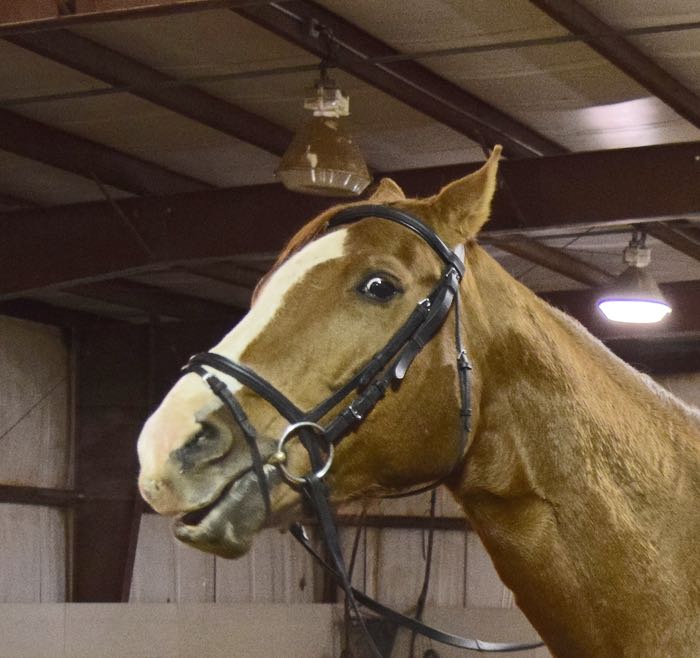The stuff that a horse wears so that a rider can securely sit on his back is called tack. Putting it on is called tacking up. I enjoy a style of riding called dressage, and for that and the frequent trail riding that I do, Tonka wears a saddle and bridle that look like this:
There are as many styles of tack as there are styles of riding, and within each discipline, there are all sorts of doodads and pieces of equipment that one can buy. I like to keep my gear simple. What Tonka has on is fairly basic. But it’s not simplistic! A horse can’t go happily with a rider on his back unless what he wears fits and is kept clean and supple.
A saddle is strapped onto the horse with a band called a girth. The girth sits behind the horse’s elbows. All parts of a horse are sensitive, but this belly area is especially so. Saddles and girths need to fit the individual horse. A bad fit is comparable to you walking around in stiff shoes of the wrong size. Pretty soon you wouldn’t want to move. Also, some horses are fussier than others. Just like some people can’t stand tags inside of their collars (one of my sons could feel a label of a snowsuit through a shirt and sweater) some horses can’t bear to have a girth of a certain material or shape. After some trial and error, I found the one
Auto Amazon Links: No products found.
Even with the tack carefully adjusted, some horses have issues when being girthed up. How you put the saddle on the horse is as important to their comfort as how well it fits. I met Lucky at my clinic in Connecticut. He’s a sensible and calm horse, however, he experienced years of someone slapping a heavy western saddle on his back and roughly pulling the cinch up tight. By the time Laura, his current owner got him, he’d had it.
Here is Lucky telling us as loudly as he could that he is afraid of the pain that inevitably happens when the girth is tightened:
Pinned ears. Wrinkled nose. Grinding teeth. Whites of the eyes showing. Head up and tense. Although his current saddle has been fit properly by a professional, Lucky has a long history of pain. It’s not enough that his tack no longer hurts. Now he has to trust that things are truly different.
Lucky is lucky. Laura is as kind as they come. But, by the time she got him, Lucky didn’t just threaten with those pinned ears, he bit. She had welts and bruises to prove it. Laura is a loving but novice horsewoman. She’d been told to not let Lucky get away with that behavior, and to back him off with a whip to protect herself. So, the pattern became: Lucky threatened her, then she threatened back. He bit, then she hit. This sort of dynamic always escalates. It never stops a horse from biting, nor does it make the owner feel safe. It did make Laura feel terrible. She loves this horse but didn’t see a way to put the whip down. She’d also been advised that when tacking up, she should wait for Lucky to look calm, then tighten up the girth. That sounds nice, but behavior science tells us that consequences drive future behavior. Lucky learned that if he relaxed, that the dreaded girth was going to be pulled up. In effect, Laura was punishing the very behavior that she wanted.
I changed this dynamic with careful observation and a few cookies. Although Lucky wasn’t about to let his guard down, he couldn’t keep the tension going without a break. After Laura set the saddle on Lucky’s back, I watched for those micro-moments of relaxation. A flick of an ear to the front and I murmured good boy and gave Lucky a cookie. When his nostrils went from three creases to two, good boy and a cookie. I didn’t pat him, because I noticed that the action of my hand going to his neck was perceived by this horse as a threat. (Always reward for what the horse likes, not what you think they should like!) Soon, Lucky’s head lowered and his eyes softened. That brought him a good boy! and a big chunk of carrot. In this way I was able to tell him that relaxing would not bring pain. Once Lucky understood that, I needed to show him that the girth no longer hurt. While I stood at his head, murmuring sweet nothings to him, I had the owner tighten the girth up one hole. Lucky’s head raised up, but one ear flicked forward. Cookies. We repeated this. Took a break. Brought the girth up one more hole. Soon, Lucky was tacked up and calm. Laura was so relieved that she could put the whip down, that she was near tears. To make girthing up an even better experience for Lucky, I advised purchasing a longer and softer girth, which Laura has ordered. (In the below photo notice how the buckles are right at the bulge of his elbow. A longer girth will alleviate that pressure.)
How generous is this horse that after years of the fear of pain, that he is still willing to believe that there is good in the people around him?
Lucky showed no tension when his owner got in the saddle. That indicated that the tack fit and that we could proceed with the riding portion of the lesson. But it became immediately clear that Lucky had learned that going forward was also all about threats and pain. He moved with reluctance. Instead of walking on when Laura squeezed with her legs, Lucky braced and worried about what was next. Because he didn’t move, Laura did what she’d been taught – she kicked – and when that didn’t get Lucky to move, she used the whip. What Lucky had been anticipating and bracing against came true. Both horse and rider were frustrated. We changed that dynamic, too. Like with the girthing up, we stopped punishing and started rewarding. By the end of the lesson, a gentle press by Laura’s calves became a cue to move on, not a threat of being stung by the whip. (How I did this took timing and skill, and I’ll have to cover that in another post.) Soon Lucky was walking on and happily cooperating with what Laura was asking of him.
Doesn’t it look like he’s saying, What’s next? Let’s do it!
You can’t change years of history in a morning, but you can change the approach. Now Laura better understands what Lucky is telling her and respects his fears. He’s no longer afraid to relax, and under saddle he’s rewarded for going forward, not punished for being slow. One week later, Laura reports:
We are making great strides (pun intended!). I’ve noticed a big difference beginning with blanket removal, and girthing is much better too. The entire process takes a lot longer, but I feel that without the time investment we will not progress. I can’ t believe how much that one clinic has helped!
I’m eagerly looking forward to my next visit with this good horse and kind owner.





That is wonderful! You’ve helped Lucky and Laura see and listen to each other instead of reacting based on past experiences and pain. We all can learn from that. Thank you.
Somehow when working with animals, there are often lessons for the broader world :)
I never knew any of this before! I had tears in my eyes by the end of the post..but this reminds me of experiences I have had with horses…..they scare me, so I have admired them from afar…..so enjoyed this story, thanks to all three of you for sharing:)
Horses are large and powerful animals, and I’ve been in plenty of scary situations. I never minimize how quickly things can become dangerous. But the more one understands, and the better the relationship one has, the safer (and happier) everyone is.
you are an amazing woman
Thank you for saying that.
Terry is truly amazing! I was quite frustrated before participating in this clinic, and now I know that we can change his behavior (and mine!).
My students who are willing to approach their horses in a new way deserve a tremendous amount of credit! I look forward to continuing this journey with you and Lucky.
Bravo Terry! What a journey Lucky and Laura can now have under your gentle, humane tutelage.
Thanks!
So, did Lucky move forward with treats? How will this work from the saddle?
Yes! Lucky was so relieved to finally be given a cue he understood. I was there to tell him the moment he got it right and to reward as he moved forward, but I’ll be teaching Laura how to effectively do this from the saddle when I’m not there. This is something that I do with Tonka. I have an example of that work in this article:http://cooperativehorse.com/words-matter/
Wonderful work Terry, you really understand both the Horse and the rider. So rewarding.
Jess is really enjoying the Western riding she now does, it took a lot of getting used to. They use a bitless browband harness, I think it is called a Headstall but not sure. She’s only uses the reins, body and leg pressure, plus voice commands for instruction, no whips or kicking. The horse is so relaxed and happy, lovely to see..:)
It sounds like she found just the right stable.
Terry, well done you! Lucky looks like a beautiful horse who is trying. I am often so humbled when I learn of the wrongs that have been done to a specific horse –either deliberately or inadvertently– and how frequently they are willing to forgive. In fact, I think the single greatest lesson I’ve learned from both dogs and horses is their amazing capacity, even eagerness, to forgive us. I hear my old childhood coach saying softly to me, over and over, “Tracy, did you apologize to that horse for (whatever?)” every single time I did not get the result I wanted. It is still one of the best lessons and perspective ‘reframers’ I’ve ever heard and I repeat it to myself all the time when an animal isn’t doing as I wish it would and I can feel impatience or judgement creeping into my mind. It’s always our fault. Always. I love your common sense, results based, kindness-themed approach to training and partnering with your animals. You are the antidote to so much that is unbalanced, unfair and ill advised about how we view these creatures. We have to listen, understand what they’re saying –which is almost always very consistent and reasonable– and ask for what works for both of us. Reading your posts is a balm to my soul. Don’t stop, don’t stop, don’t stop.
You’ve had very, very good training! I also believe in apologizing to my horse when he doesn’t do as I ask. Either I’ve over-faced him, or asked badly, or confused him, or did something… which leads to frustration by both of us… apologizing takes the edge off of my demands and brings me back to the right mental place to figure out how to proceed.
Terry just to let you know Jess cleans and grooms for a private owner who has 3 horses, 1 retired, 1 the lady rides and one she teaches Jess to ride on and use in return for her work. The lady has worked with horses all her life and is very knowledgeable and compassionate. Jess was lucky to find her so local as we are not keen on the big riding stables…:)
That owner is lucky to have Jess! Hardworking, kind and consistent barn help is worth more than gold.
Terry I noticed that you don’t wear/use spurs, thank goodness. I always looked at them as things of torture. Are there any times when they are necessary?
I don’t think that spurs are necessary; many are severe and cause pain. In a perfect world, the only riders using them would have the quietest of legs, and the spur would be the most subtle and precise cue for the horse to move in a certain way. Unfortunately, even people who use small spurs often jam them into their horses’ sides with each stride.
Terry, what’s the extra strap/thong(?) for around Lucky’s nose and mouth? Is it meant to keep the bit in place?
Good question. That’s called a flash noseband. It’s purpose is to keep the mouth closed. Tense horses flap their lips, grind their teeth, open their mouths, etc. and that helps to keep the mouth still. All of those behaviors are things that you’d rather not see – and are often caused by heavy-handed training, the wrong bit, fear issues, etc. Sometimes it’s there to keep the bit properly in place and isn’t onerous to the horse. I can’t change everything in one morning clinic, but as we progress, we’ll address some of the reasons that Lucky is wearing that, and hopefully make changes so that we can take it off.
This is a beautiful story. Kindness, patience and understanding go such a long way. As I read this, I thought the situation reminded me immensely about dogs that are rescued and finally can find peace, love and understanding. Kudos to Laura for her kindness and willingness to love this horse so thoroughly.
The science that makes what I do so effective is applicable to all creatures. But it’s heart and generosity that makes it so wonderful to do.
All about communication. I’ve little experience with horses, and tend to not trust them the day one of them disregarded my directions and followed his owner, his mind reading something like “Hey, the master is going this way! This guy on my back will scrape off if I go under a low tree branch, then I can get more brushing from the master…” Perhaps if I was the one applying the curry comb that day….
By the way, the saddle for Tonka is quite nice, but you have one sharp looking horse under it there.
Jp
Many horses have figured out how to rub their riders off on trees. I know from firsthand experience :)
And the trick is not to figure out how to prevent the horse from scraping you off, but to be the rider the horse doesn’t plot to remove!